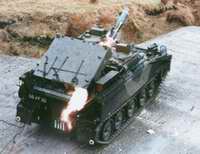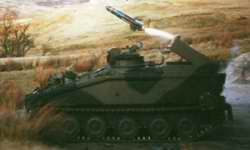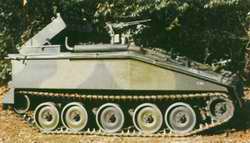| Designation: | FV102 Striker SP |
 |
|---|---|---|
| Manufacturer: | ALVIS PLC | |
| Product type: | Armoured Vehicles | |
| Name: | Self-propelled antitank guided missile system |
FV102 Striker is the Swingfire wire guided anti-tank missile carrying member of the CVR(T) family. Five missiles ready to fire and five stowed are carried. The missiles have hollow charge warheads and were originally steered by joystick control, later updated to the Automatic Command Line of Site (ACLOS) system where the controller merely sights the target. The missiles are fired at a fixed elevation of 35º and have an effective range of 4000 metres.
Striker entered service in 1976 with the Royal Artillery of the BAOR, but since then have been transferred to the Royal Armoured Corps.
The Striker anti-tank guided weapon vehicle is a member of the Scorpion Combat Vehicle Reconnaissance (Tracked) family of vehicles, which is covered in a separate entry.
Alvis was responsible for the chassis with what is now MBDA responsible for the missile system and the Swingfire ATGW.
Following trials and acceptance for service by the British Army, first production vehicles were completed in June 1975 and the Striker entered service in 1976.
Within the British Army it is issued to the anti-tank units of the Royal Armoured Corps deployed with the reconnaissance regiments.
First deliveries to the Belgian Army were made in June 1976 and it took delivery of a total of 43 Striker vehicles, which have now been withdrawn from service.
Production of all members of the Scorpion Combat Vehicle Reconnaissance (Tracked) was undertaken at Coventry. Production of the Scorpion family of vehicles was transferred to the former GKN Defence facility at Telford. There has been no production of the baseline Scorpion vehicle for 10 years.
As a result of mergers and acquisitions, late in 2004 Alvis Vickers became BAE Systems Land Systems UK.
From 2007/2008 Striker will be replaced by a modified Spartan APC, which will carry dismounted Javelin ATGW systems.
The Striker is based on the hull of the Spartan APC with the driver at the front on the left with the power pack to his right. The commander is to the rear of the driver with the missile controller to his right. Automotive aspects are identical to the Scorpion family of vehicles.
The commander has a No 26 cupola, which has eight day periscopes and a monocular day sight with a magnification of ×1 or ×10, the line of sight elevating with the 7.62 mm machine gun. The ×1 mirror assembly can be replaced by a ×1.8 image intensifier.
Mounted on the right side of the cupola is a 7.62 mm machine gun which can be aimed and fired from within the vehicle. The cupola has a single-piece hatch cover that opens to the left.
The missile controller has the Barr & Stroud (now Thales Land & Joint Systems) Combined Sight (CS) which has both thermal and visual optics with magnifications of ×2 or ×6 (thermal) or ×2 and ×10 (day) respectively. The sight can be traversed through 55° left and right, and a single-piece hatch cover that opens to the right is provided to the rear of this sight.
On the top at the rear of the vehicle is a launcher box with five of the now MBDA Swingfire ATGWs. A further five missiles carried inside the vehicle are loaded manually and one of the crew has to leave the vehicle to accomplish this. The launcher box is pivoted at the rear and is elevated to an angle of about 35° before the missiles are launched.
The Swingfire missile weighs 28 kg and has a HEAT warhead. Minimum range is between 150 and 300 m depending on the distance of the vehicle and the controller when being used in the separated mode.
Maximum range of the Swingfire is 4,000 m. An advantage of the Swingfire ATGW system over other systems is that the missiles can be launched from behind a crest or cover so that the launcher position cannot be seen by the enemy.
The Swingfire missiles can be launched by the controller in the vehicle, or with the controller at a vantage point (up to 100 m from the launcher) separated from the launcher giving him protection from counterfire.
Mounted at the front of the vehicle are two four-barrel 66 mm electrically operated smoke grenade dischargers which are operated from within the vehicle.
Standard equipment for the Striker tank destroyer includes an overpressure NBC system.
Following on from 'proof of principle' research programmes by the then Royal Armament Research and Development Establishment (RARDE) and the then British Aerospace, in mid-1990 the UK MoD awarded a £35 million five year contract to the now MBDA, for the implementation of the Swingfire Improved Guidance (SWIG) programme into the Striker.
First production standard modified vehicles were delivered in July 1995 and the last of 60 upgraded vehicles were handed over to the British Army late in 1996.
The SWIG modification involved virtually a complete replacement of the existing analogue electronics ground control equipment by new digital technology electronic units.
The system retains the existing dual-mode, visual/thermal Combined Sight which entered service in 1980. The updated ground control equipment incorporates a comprehensive Built In Test (BIT) facility which, combined with the much improved reliability, substantially increases system availability.
The improved system offers a simple to use ACLOS (Automatic Command to Line Of Sight) guidance mode so reducing operator training needs. The existing MANCLOS (Manual Command to Line Of Sight) mode is retained, for direct fire reversionary capability, as is the versatile separated fire mode, where the operator can be positioned remotely, up to 100 m from the launching vehicle.
The ACLOS guidance system uses thermal image data from the combined sight to automatically track both the target and the missile and effect command to line of sight guidance, independently of the operator.
To engage in the ACLOS mode the operator positions a movable electronic cross-wire into the region of the target and initiates the target tracker. Target tracking is now autonomous, while the operator launches and gathers the missile.
Once the missile enters the field of view, guidance is fully automatic until target impact. Sophisticated tracking logic allows the system to cope with a wide variety of potentially decoying effects.
The SWIG modification also incorporates a mini-compressor for thermal sight cooling, freeing the vehicle from the logistic constraints of high-pressure bottled air. A comprehensive workstation-based, second-line test facility for the new SWIG line-replaceable units has been incorporated into an existing support vehicle.
In August 1997, following extensive trials between Scorpion light armoured vehicles fitted with diesel engines supplied by the Cummins Engine Company (UK), Perkins Engines Company (UK) and Steyr-Daimler-Puch (Austria), the UK MoD selected the Cummins 6BTA 5.9 litre six-cylinder diesel developing 235 hp.
All operational British Army CVR(T) family of tracked vehicles will have had their current Jaguar 4.2 litre petrol engines replaced by the more fuel efficient Cummins diesel engine.
The 73 mm Scorpion member of the CVR(T) has been withdrawn from service with the British Army but all other versions remain in service including the Scimitar and Sabre (30 mm), Samson recovery vehicle, Sultan command post vehicle, Striker anti-tank vehicle, Spartan troop carrier and Samaritan ambulance.
The installation of the Cummins diesel engine also requires some modifications to other subsystems of the CVR(T) such as the transmission.
The Telford facility has converted the first 200 Scorpion's with the Cummins diesel engine at Telford and the first of these was handed over to the British Army in April 1999. There was a competition for the next batch of 600 vehicles and this was won by the Army Base Repair Organisation (ABRO) facility at Donnington. The upgrade is now complete.
|
||||||||||||||||||
|
|||||||||
 |
 |
 |
 |
